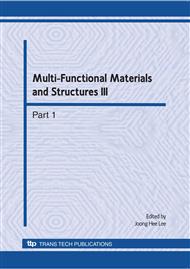p.1063
p.1067
p.1071
p.1075
p.1079
p.1083
p.1087
p.1091
p.1095
Effect of Carbon Fillers on the Performance of a Composite Bipolar Plate for Fuel Cells
Abstract:
The bipolar plates were fabricated using compression molding of graphite (GR), carbon black (CB), multi-wall carbon nanotubes (MWNTs), carbon fibers (CF) and powder type epoxy resin. The electrical conductivity and flexural properties of the composites was increased with increasing the content of fibrous conducting fillers e.g., MWNTs and CF. However, when particulate fillers such as CB and GR were used, the electrical conductivity was increased, but the flexural properties deteriorated with increasing filler content up to certain content. A comparison was also made between the current-voltage (I-V) performances of fabricated composite bipolar plates and commercial graphite bipolar plate. The I-V characteristic in single cell test exhibited more uniform power density at both higher and lower current density and single cell performance increased with increasing the electrical conductivity.
Info:
Periodical:
Pages:
1079-1082
Citation:
Online since:
August 2010
Authors:
Price:
Сopyright:
© 2010 Trans Tech Publications Ltd. All Rights Reserved
Share:
Citation:


